-
1 of 253523 objects
Hercules, Antaeus and Gaia seventeenth century
Bronze | 64.8 x 30.0 x 32.5 cm (whole object) | RCIN 21929
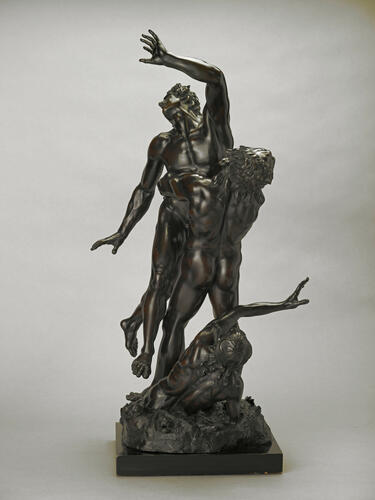
Germany
Hercules and Antaeus seventeenth century
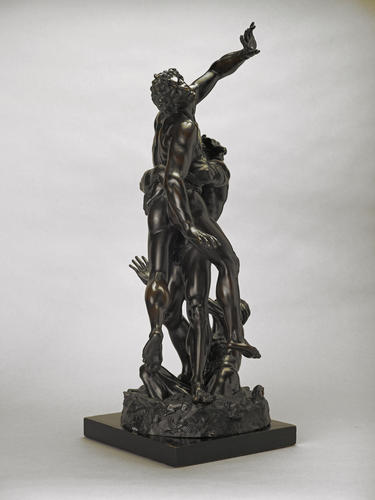
Germany
Hercules and Antaeus seventeenth century
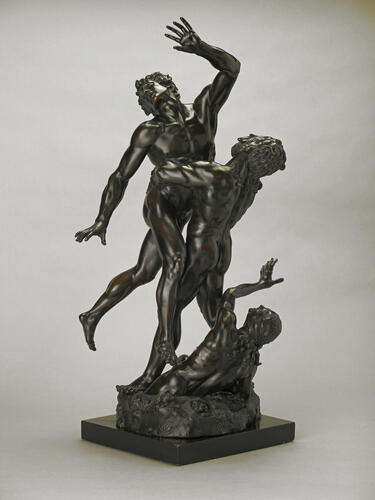
Germany
Hercules and Antaeus seventeenth century
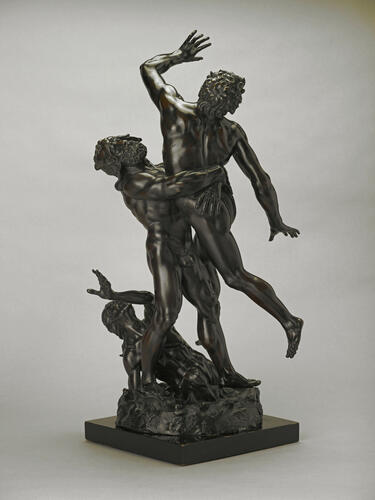
Germany
Hercules and Antaeus seventeenth century
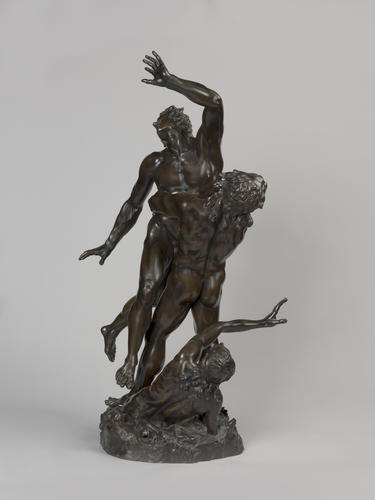

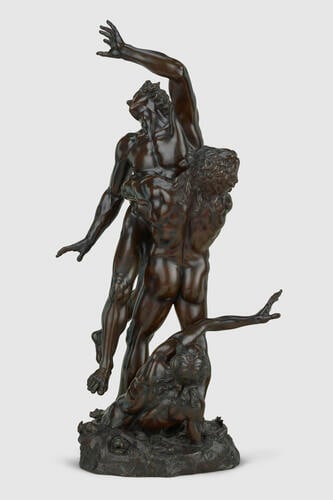
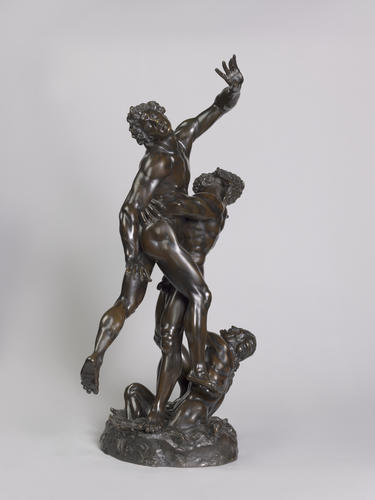
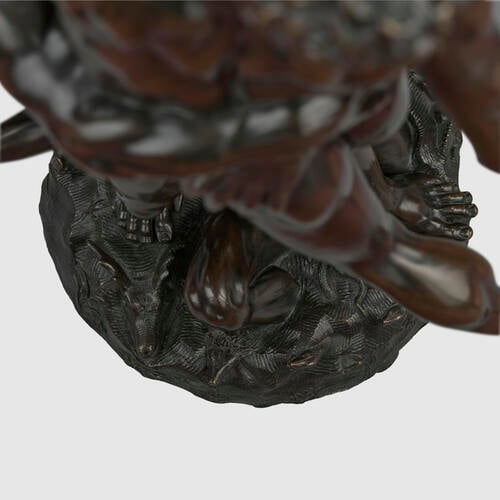
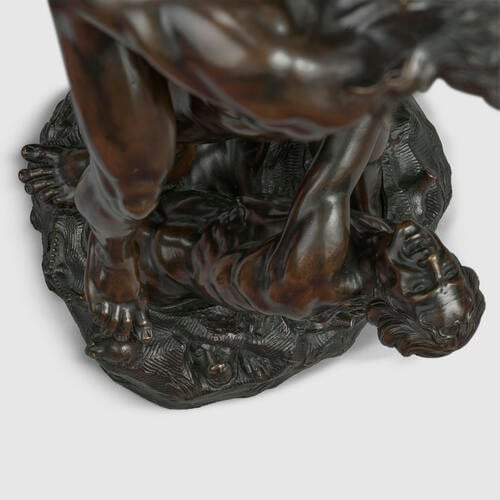

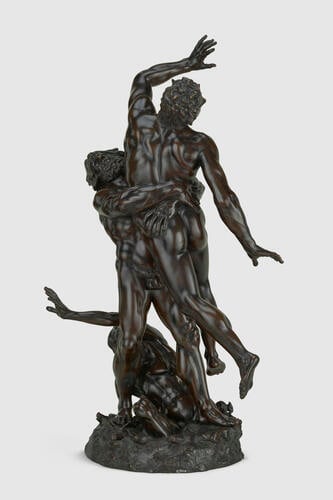
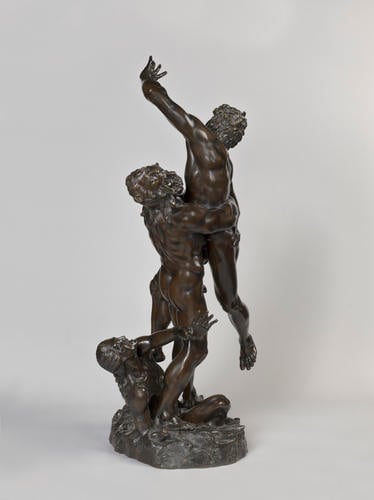
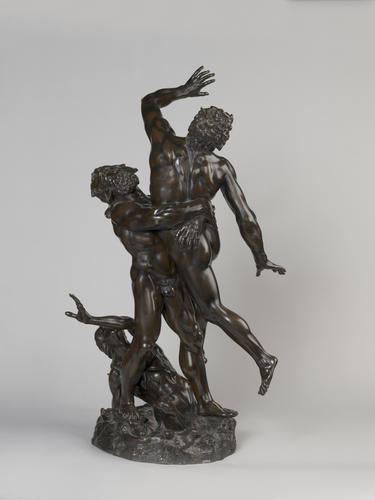




-
A bronze group of three figures. The bearded Hercules, naked except for a lion mask worn as a hood, stands gripping the waist of Antaeus. The youthful figure of Antaeus, also naked, with his legs hanging
in space, holds his head sharply back and to the right, his anguished face with open mouth and eyebrows sharply raised. His left hand is raised and his right extended below. Below them is the naked, haggard, half-figure of Gaia, who appears half-submerged in the naturalistic base, with her right leg bent at the knee and passing between Hercules’ legs. Her head, with long hair at the back and an open mouth, is thrown backwards as she leans on her right elbow. The base is modelled naturalistically with mouse, lizard, deer and a boar (?) appearing to emerge from the ground.
This spectacular group depicts Hercules struggling with the giant Antaeus, son of Poseidon and Gaia. According to Ovid, the only way that Hercules could kill Antaeus was by preventing him from contact with the ground. In this case, the inclusion of Gaia – the goddess of Earth – strengthens the narrative (Antaeus is being separated not only from his life-force but from his mother). The variety of approaches to this subject seems to suggest that it was considered a challenge to bronze sculptors to invent the perfect composition.
The creator of this bonze group remains unknown, and indeed it is hard to attribute a region or nationality. Sculptors often chose this subject to show off their powers of design and expression, and many small bronzes exist. Some of these depend on the colossal ancient marble restored and displayed in Florence in the 1560s (Florence, Palazzo Pitti). A composition in which the two principal figures face one another (as in this case) was invented by Antonio Pollaiuolo in the 1470s. The enthusiasm for Herculean subjects on the part of the Medici gave rise to further versions of the group including a colossal bronze by Bartolomeo Ammannati (Villa Medici, Castello) and small bronze groups that have been attributed to the Dutch-born associate of Cellini Willem Danielsz. van Tetrode (1530–87; alias ‘Guglielmo Fiammingo’),and Giambologna. However, this version is distinguished from all these predecessors by its unusual size (it is almost 50% taller than any of the others), by the composition of the two combatants, and by the inclusion of the third figure. The approach to the lion pelt (representing that of the Nemean Lion slain by Hercules) is also unusual. While he is often portrayed with the skin of the animal’s head worn over his, more usually the rest of the pelt hangs down his back to some extent. Here, the remainder of the pelt is absent, leaving what is effectively a cap.
The conception of the base as The Earth, a sort of microcosm inhabited by creatures of all kinds, may have its origins in the famous salt-cellar made in 1540–3 in enamelled gold for François I by Benvenuto Cellini, with its figures of Earth and Water. Beneath the figure of the Sea, Cellini modelled ‘different kinds of fishes and other marine creatures’, while the female figure of Earth presided over ‘the most beautiful animals which the earth produces.’ This idea of populating the base of a sculpture or work of silver with ‘all of creation’ seems to have taken root in German art of the sixteenth century. The goldsmith Wenzel Jamnitzer (1508–85) created some of the most intricate examples, often using life-casting techniques for the creatures. In the case of this bronze, the Earth is central to the story. The maker presumably had this in mind in designing it so that Gaia, the personification of Earth, was cast integrally with the base, while Hercules was merely attached.
This group was purchased by George IV from Rundell, Bridge and Rundell in August 1824 for £63. It is not known where Rundells acquired it, but among bronzes sold on the London market in the years prior to its acquisition by George IV, lot 32 on the second day of the Marchioness of Thomond’s sale in 1821 was ‘A bronze group of Hercules and Antaeus 25 inches high.'
Text adapted from Sculpture in the Collection of His Majesty The King (2025)Provenance
Purchased by George IV from Rundell, Bridge and Rundell in August 1824 for £63; Windsor Castle, Green Drawing Room; Grand Corridor; Crimson Drawing Room; Grand Reception Room.
-
Creator(s)
(nationality)Acquirer(s)
-
Medium and techniques
Bronze
Measurements
64.8 x 30.0 x 32.5 cm (whole object)
Alternative title(s)
Antaeus crushed by Hercules; Hercules, Antaeus and Gaiea